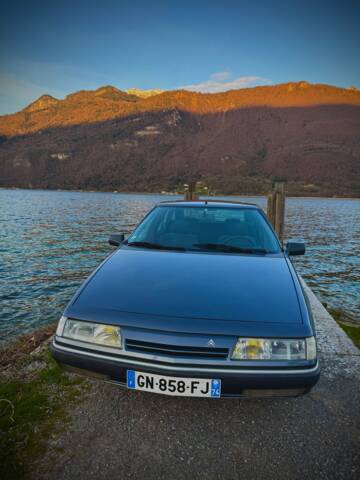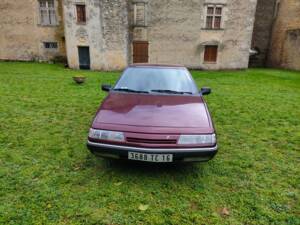Citroën XM classic car for sale
The Citroën XM, produced between 1989 and 2000, stands out with its electronically controlled hydropneumatic suspension and unmistakable design. Available as a hatchback or versatile estate, the XM offers an advanced driving experience, luxurious features, and a spacious interior, making it a distinctive choice in the executive car class.
Search results


1991 | Citroën XM 2.1 D12
Parfait état
History
Launched in 1989 as Citroën's flagship saloon, the XM succeeded the revered CX and introduced a new era of technological innovation for the brand. The XM was the first production car to use electronically controlled hydropneumatic suspension—Hydractive—which varied ride comfort and dynamics, setting it apart from its main rivals. It was voted European Car of the Year in 1990, cementing its role as a technical pioneer. Over its eleven-year production run, 333,775 units were manufactured, but sales declined in the late 1990s despite a facelift in 1994, new safety features, and updated styling. The XM had to compete with the likes of the Peugeot 605, BMW 5 Series, and Audi 100 and was available in both hatchback and estate versions. Although never a commercial runaway, the XM remains notable today for its innovation and the loyalty it inspired among Citroën devotees.
Model history
The Citroën XM replaced the iconic Citroën CX in 1989 and continued Citroën's tradition of large, avant-garde executive cars. The model range began with the five-door hatch (Berline) and expanded in 1991 to include the spacious estate (Break). Throughout its lifespan, the XM was offered with a wide range of petrol and diesel engines, including the notable 2.0 16V, 2.0 Turbo CT, and the powerful 3.0 V6—with both 12- and 24-valve versions. Transmission options included both five-speed manual and automatic gearboxes. Facelifts in 1994 addressed not only cosmetic updates—like modernised dashboards and safer door trims—but also mechanical improvements, such as enhanced passive rear steering. Series 1.5 models (early 1992) featured a mixture of new technologies, especially in suspension. The succession plan saw the XM ultimately replaced by the Citroën C5 in 2000.
Highlights
The key distinguishing feature of the Citroën XM is its Hydractive suspension, which delivers unprecedented ride quality by electronically switching between comfort and sport modes. The XM was among the first to offer plenty of luxury goodies for its class: electronically adjustable and heated seats, climate control, ABS, and advanced security functions like the coded ignition lock. The estate model is particularly practical, with up to 1200 litres of boot space and versatile folding seats. The range featured rare collector editions such as the XM Multimedia. Safety received a substantial boost post-1994 with standard driver airbags and improved crash protection. The car's lighting—with its unique high-beam setup—and the option of a sophisticated Philips HiFi CD changer and navigation set the standard for French executive cars of the time.
Technical data
Special Editions and Collectible Models
Notable is the ultra-rare "XM Multimedia," produced in 1997 in just 52 units, featuring unique factory multimedia equipment for VIP events. Various high-spec trim levels like "Pallas" and "Ambiance" added luxury touches, while limited series often featured full options, such as special paint colours (Vert Vega, Gris Silex) and distinctive design elements.
Weak spots and common issues
The XM is acclaimed for its revolutionary suspension and comfort but is equally notorious for complex electronics and Hydractive system reliability. Electrical and hydraulic issues increase with age, demanding experienced hands for servicing. Hydractive repairs can be costly and time-consuming; spare parts for less common variants are not always easy to source. Early models suffer from weaker rust protection, though this improved on later versions. Fuel consumption is relatively high, especially for V6 models. Well-maintained examples are typically cherished by specialists, but XM ownership requires engagement and mechanics knowledge.
Engine and Performance, Transmission and Handling
The XM's Hydractive chassis delivers a ride unmatched by contemporary competitors, with selectable comfort and sport damping. Power ranged from practical diesel units—favoured for their economy and torque—to refined 24V V6 engines pushing the estate past 200km/h. Steering benefited from the Diravi variable power steering, and automatic and manual transmissions supported a broad user base. The combination of advanced chassis, aggressive aerodynamics, and high-torque engines defined the XM's driving character. • XM 3.0 V6 24V (200hp) • XM 2.0 Turbo CT • XM Break (Estate) variants • Diesel options for long-distance commuters All versions stand out for their blend of comfort, performance, and technical sophistication.
Interior, Comfort, Exterior and Design
The XM's distinctive lines, designed by Bertone, feature large windows and Citroën's hallmark wedge profile. Interior options range from lush leather or Alcantara upholstery to technologically advanced dashboards with comprehensive on-board computer systems. Equipped with original Clarion cassette radios (often with steering wheel controls), air conditioning, electrically operated and heated seats, and multiple reading lamps, the XM was ahead of its time in comfort. Accessories include alloy wheels, factory navigation systems, sunroofs, metallic paint options, and unique features like the '13th window' for extra light in the rear pillar. Estates deliver enormous cargo flexibility, while rare colour options and special trims distinguish high-end and special order cars.
Other features
Ambulance conversions continued the Citroën tradition of tailoring the XM for specialist use. Some models were fitted with advanced navigation and Hifi systems. The XM holds an active presence in classic car events and is acknowledged among enthusiasts for both its design and driving abilities.
Summary
With its blend of avant-garde suspension technology, opulent comfort, and dramatic design, the Citroën XM occupies a singular place in automotive history. It appeals to specialists and classic car enthusiasts who appreciate its genuine technical innovations, distinctive styling by Bertone, and practical estates. The XM is a technical and cultural outlier—rewarding to those who embrace its engineering and prepared for its maintenance demands.

